Analysis of Indigenous Education and Global Indigeneity Movements
VerifiedAdded on 2021/06/18
|9
|2517
|39
Essay
AI Summary
This essay delves into the multifaceted realm of indigenous education and perspectives, examining the global indigeneity movement and its impact on indigenous groups' reliance on national political processes. It highlights the historical and ongoing struggles faced by indigenous populations worldwide, including the Torres Islanders and Aboriginal people of Australia, and the Dalits of India, among others, emphasizing their shared grievances stemming from governmental reluctance in providing basic rights and services. The essay analyzes specific examples, such as the 'Closing the Gap' strategy in Australia, and how governmental actions and inactions have fueled movements aimed at reducing dependence on national governments. It also discusses the challenges governments face in balancing development with the preservation of indigenous cultures and traditions, and the implications of these issues on indigenous communities' well-being and social justice. The essay concludes by emphasizing the need for global leaders to address the issue of indigenous education and perspectives with aligned views.
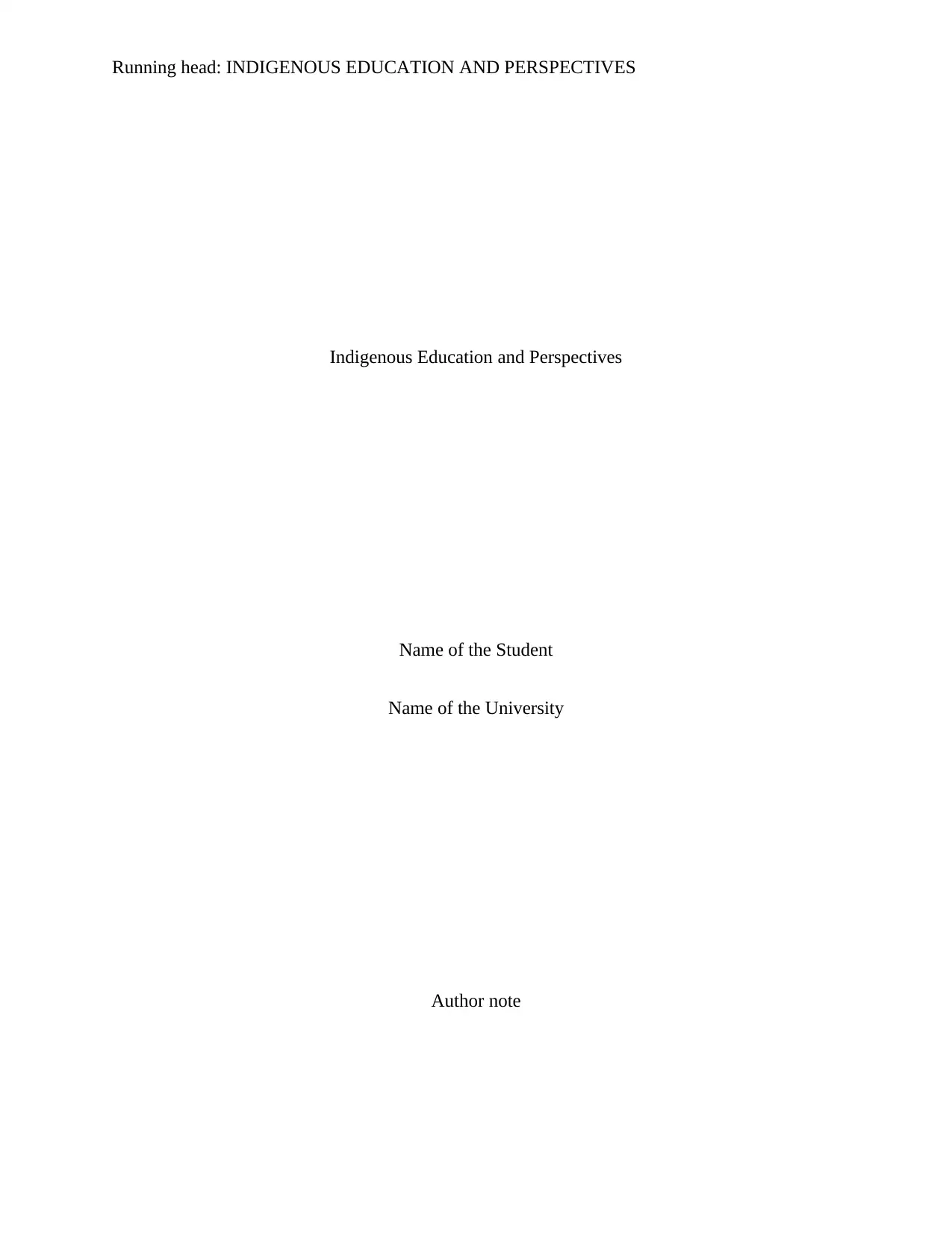
Running head: INDIGENOUS EDUCATION AND PERSPECTIVES
Indigenous Education and Perspectives
Name of the Student
Name of the University
Author note
Indigenous Education and Perspectives
Name of the Student
Name of the University
Author note
Paraphrase This Document
Need a fresh take? Get an instant paraphrase of this document with our AI Paraphraser
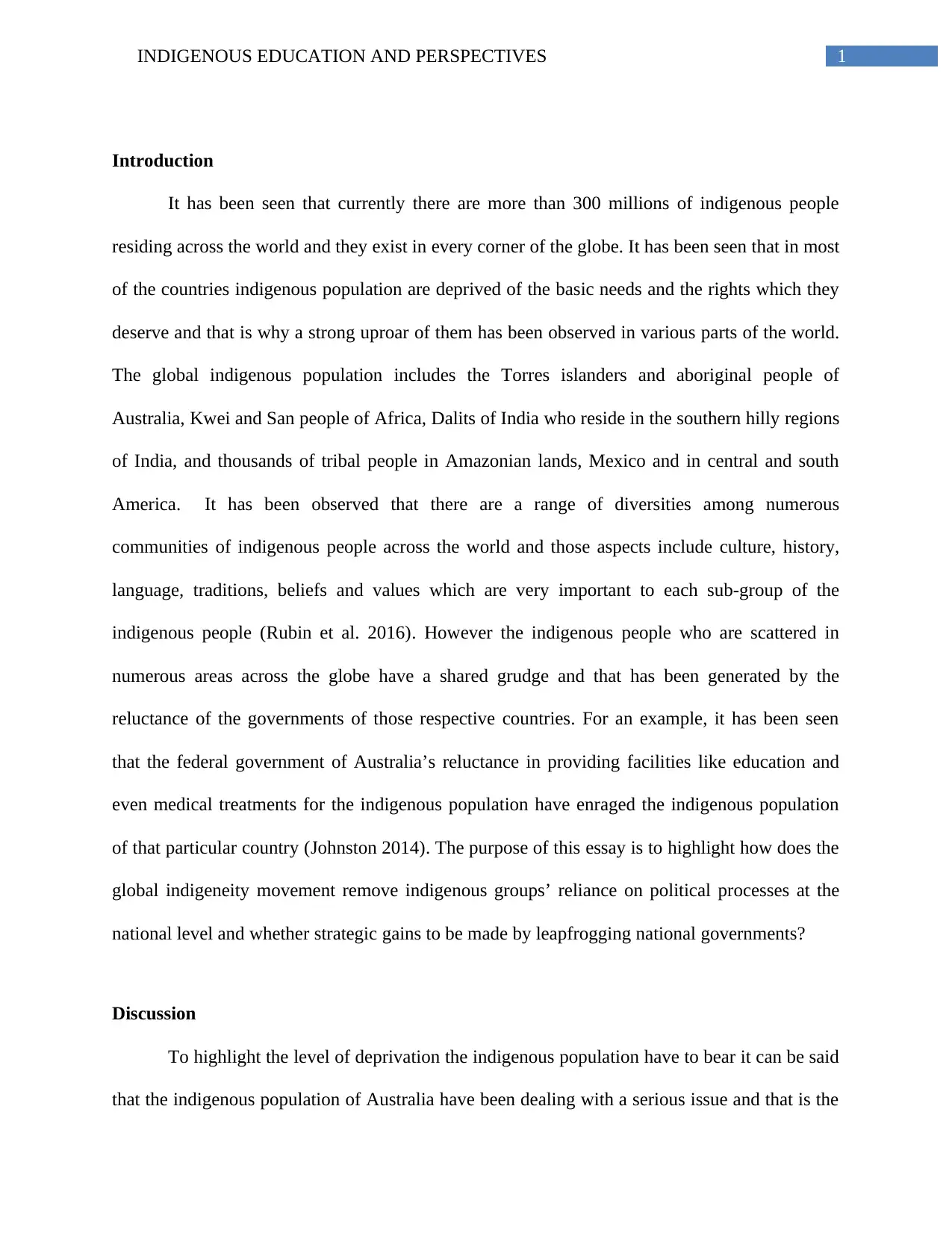
1INDIGENOUS EDUCATION AND PERSPECTIVES
Introduction
It has been seen that currently there are more than 300 millions of indigenous people
residing across the world and they exist in every corner of the globe. It has been seen that in most
of the countries indigenous population are deprived of the basic needs and the rights which they
deserve and that is why a strong uproar of them has been observed in various parts of the world.
The global indigenous population includes the Torres islanders and aboriginal people of
Australia, Kwei and San people of Africa, Dalits of India who reside in the southern hilly regions
of India, and thousands of tribal people in Amazonian lands, Mexico and in central and south
America. It has been observed that there are a range of diversities among numerous
communities of indigenous people across the world and those aspects include culture, history,
language, traditions, beliefs and values which are very important to each sub-group of the
indigenous people (Rubin et al. 2016). However the indigenous people who are scattered in
numerous areas across the globe have a shared grudge and that has been generated by the
reluctance of the governments of those respective countries. For an example, it has been seen
that the federal government of Australia’s reluctance in providing facilities like education and
even medical treatments for the indigenous population have enraged the indigenous population
of that particular country (Johnston 2014). The purpose of this essay is to highlight how does the
global indigeneity movement remove indigenous groups’ reliance on political processes at the
national level and whether strategic gains to be made by leapfrogging national governments?
Discussion
To highlight the level of deprivation the indigenous population have to bear it can be said
that the indigenous population of Australia have been dealing with a serious issue and that is the
Introduction
It has been seen that currently there are more than 300 millions of indigenous people
residing across the world and they exist in every corner of the globe. It has been seen that in most
of the countries indigenous population are deprived of the basic needs and the rights which they
deserve and that is why a strong uproar of them has been observed in various parts of the world.
The global indigenous population includes the Torres islanders and aboriginal people of
Australia, Kwei and San people of Africa, Dalits of India who reside in the southern hilly regions
of India, and thousands of tribal people in Amazonian lands, Mexico and in central and south
America. It has been observed that there are a range of diversities among numerous
communities of indigenous people across the world and those aspects include culture, history,
language, traditions, beliefs and values which are very important to each sub-group of the
indigenous people (Rubin et al. 2016). However the indigenous people who are scattered in
numerous areas across the globe have a shared grudge and that has been generated by the
reluctance of the governments of those respective countries. For an example, it has been seen
that the federal government of Australia’s reluctance in providing facilities like education and
even medical treatments for the indigenous population have enraged the indigenous population
of that particular country (Johnston 2014). The purpose of this essay is to highlight how does the
global indigeneity movement remove indigenous groups’ reliance on political processes at the
national level and whether strategic gains to be made by leapfrogging national governments?
Discussion
To highlight the level of deprivation the indigenous population have to bear it can be said
that the indigenous population of Australia have been dealing with a serious issue and that is the
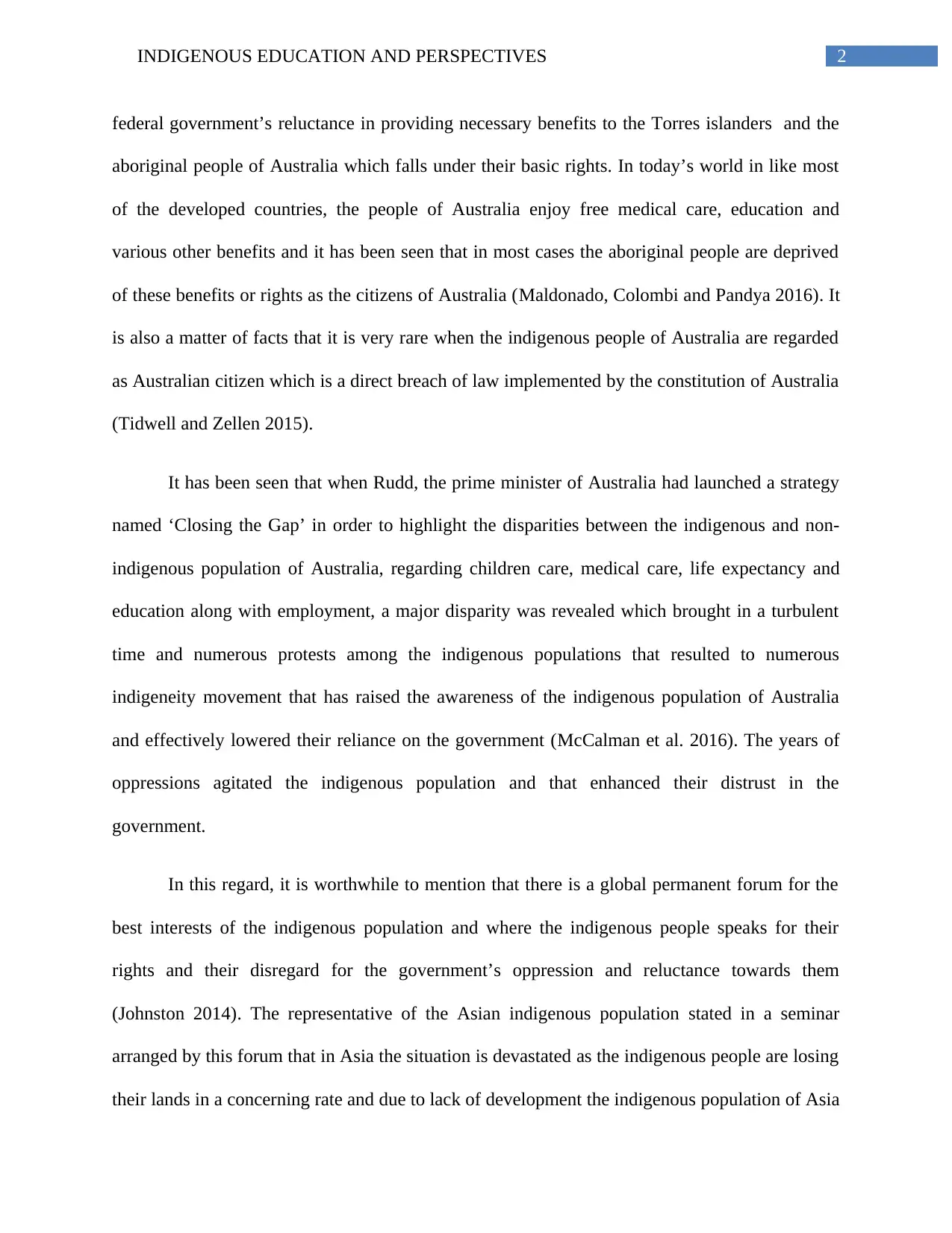
2INDIGENOUS EDUCATION AND PERSPECTIVES
federal government’s reluctance in providing necessary benefits to the Torres islanders and the
aboriginal people of Australia which falls under their basic rights. In today’s world in like most
of the developed countries, the people of Australia enjoy free medical care, education and
various other benefits and it has been seen that in most cases the aboriginal people are deprived
of these benefits or rights as the citizens of Australia (Maldonado, Colombi and Pandya 2016). It
is also a matter of facts that it is very rare when the indigenous people of Australia are regarded
as Australian citizen which is a direct breach of law implemented by the constitution of Australia
(Tidwell and Zellen 2015).
It has been seen that when Rudd, the prime minister of Australia had launched a strategy
named ‘Closing the Gap’ in order to highlight the disparities between the indigenous and non-
indigenous population of Australia, regarding children care, medical care, life expectancy and
education along with employment, a major disparity was revealed which brought in a turbulent
time and numerous protests among the indigenous populations that resulted to numerous
indigeneity movement that has raised the awareness of the indigenous population of Australia
and effectively lowered their reliance on the government (McCalman et al. 2016). The years of
oppressions agitated the indigenous population and that enhanced their distrust in the
government.
In this regard, it is worthwhile to mention that there is a global permanent forum for the
best interests of the indigenous population and where the indigenous people speaks for their
rights and their disregard for the government’s oppression and reluctance towards them
(Johnston 2014). The representative of the Asian indigenous population stated in a seminar
arranged by this forum that in Asia the situation is devastated as the indigenous people are losing
their lands in a concerning rate and due to lack of development the indigenous population of Asia
federal government’s reluctance in providing necessary benefits to the Torres islanders and the
aboriginal people of Australia which falls under their basic rights. In today’s world in like most
of the developed countries, the people of Australia enjoy free medical care, education and
various other benefits and it has been seen that in most cases the aboriginal people are deprived
of these benefits or rights as the citizens of Australia (Maldonado, Colombi and Pandya 2016). It
is also a matter of facts that it is very rare when the indigenous people of Australia are regarded
as Australian citizen which is a direct breach of law implemented by the constitution of Australia
(Tidwell and Zellen 2015).
It has been seen that when Rudd, the prime minister of Australia had launched a strategy
named ‘Closing the Gap’ in order to highlight the disparities between the indigenous and non-
indigenous population of Australia, regarding children care, medical care, life expectancy and
education along with employment, a major disparity was revealed which brought in a turbulent
time and numerous protests among the indigenous populations that resulted to numerous
indigeneity movement that has raised the awareness of the indigenous population of Australia
and effectively lowered their reliance on the government (McCalman et al. 2016). The years of
oppressions agitated the indigenous population and that enhanced their distrust in the
government.
In this regard, it is worthwhile to mention that there is a global permanent forum for the
best interests of the indigenous population and where the indigenous people speaks for their
rights and their disregard for the government’s oppression and reluctance towards them
(Johnston 2014). The representative of the Asian indigenous population stated in a seminar
arranged by this forum that in Asia the situation is devastated as the indigenous people are losing
their lands in a concerning rate and due to lack of development the indigenous population of Asia
⊘ This is a preview!⊘
Do you want full access?
Subscribe today to unlock all pages.

Trusted by 1+ million students worldwide
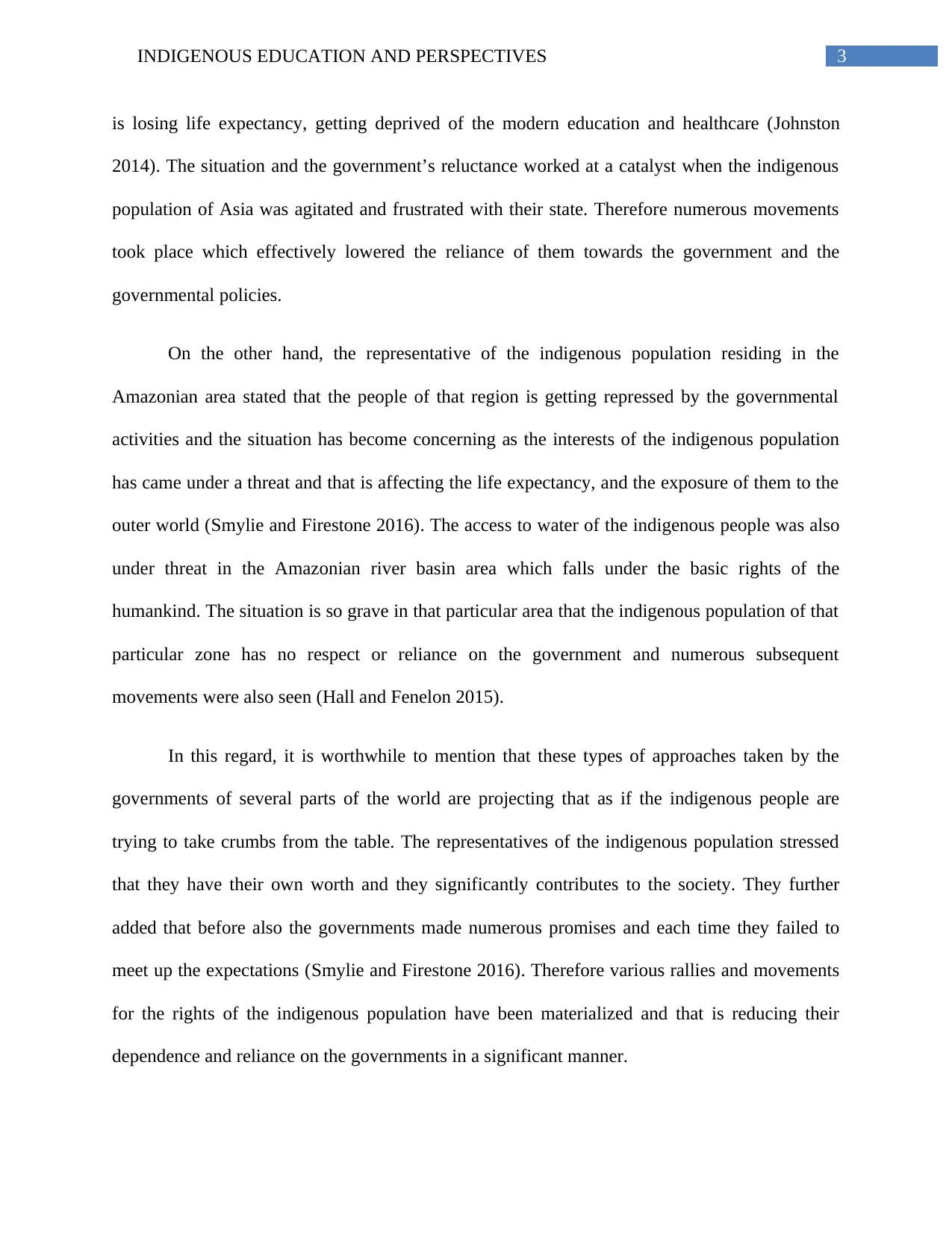
3INDIGENOUS EDUCATION AND PERSPECTIVES
is losing life expectancy, getting deprived of the modern education and healthcare (Johnston
2014). The situation and the government’s reluctance worked at a catalyst when the indigenous
population of Asia was agitated and frustrated with their state. Therefore numerous movements
took place which effectively lowered the reliance of them towards the government and the
governmental policies.
On the other hand, the representative of the indigenous population residing in the
Amazonian area stated that the people of that region is getting repressed by the governmental
activities and the situation has become concerning as the interests of the indigenous population
has came under a threat and that is affecting the life expectancy, and the exposure of them to the
outer world (Smylie and Firestone 2016). The access to water of the indigenous people was also
under threat in the Amazonian river basin area which falls under the basic rights of the
humankind. The situation is so grave in that particular area that the indigenous population of that
particular zone has no respect or reliance on the government and numerous subsequent
movements were also seen (Hall and Fenelon 2015).
In this regard, it is worthwhile to mention that these types of approaches taken by the
governments of several parts of the world are projecting that as if the indigenous people are
trying to take crumbs from the table. The representatives of the indigenous population stressed
that they have their own worth and they significantly contributes to the society. They further
added that before also the governments made numerous promises and each time they failed to
meet up the expectations (Smylie and Firestone 2016). Therefore various rallies and movements
for the rights of the indigenous population have been materialized and that is reducing their
dependence and reliance on the governments in a significant manner.
is losing life expectancy, getting deprived of the modern education and healthcare (Johnston
2014). The situation and the government’s reluctance worked at a catalyst when the indigenous
population of Asia was agitated and frustrated with their state. Therefore numerous movements
took place which effectively lowered the reliance of them towards the government and the
governmental policies.
On the other hand, the representative of the indigenous population residing in the
Amazonian area stated that the people of that region is getting repressed by the governmental
activities and the situation has become concerning as the interests of the indigenous population
has came under a threat and that is affecting the life expectancy, and the exposure of them to the
outer world (Smylie and Firestone 2016). The access to water of the indigenous people was also
under threat in the Amazonian river basin area which falls under the basic rights of the
humankind. The situation is so grave in that particular area that the indigenous population of that
particular zone has no respect or reliance on the government and numerous subsequent
movements were also seen (Hall and Fenelon 2015).
In this regard, it is worthwhile to mention that these types of approaches taken by the
governments of several parts of the world are projecting that as if the indigenous people are
trying to take crumbs from the table. The representatives of the indigenous population stressed
that they have their own worth and they significantly contributes to the society. They further
added that before also the governments made numerous promises and each time they failed to
meet up the expectations (Smylie and Firestone 2016). Therefore various rallies and movements
for the rights of the indigenous population have been materialized and that is reducing their
dependence and reliance on the governments in a significant manner.
Paraphrase This Document
Need a fresh take? Get an instant paraphrase of this document with our AI Paraphraser
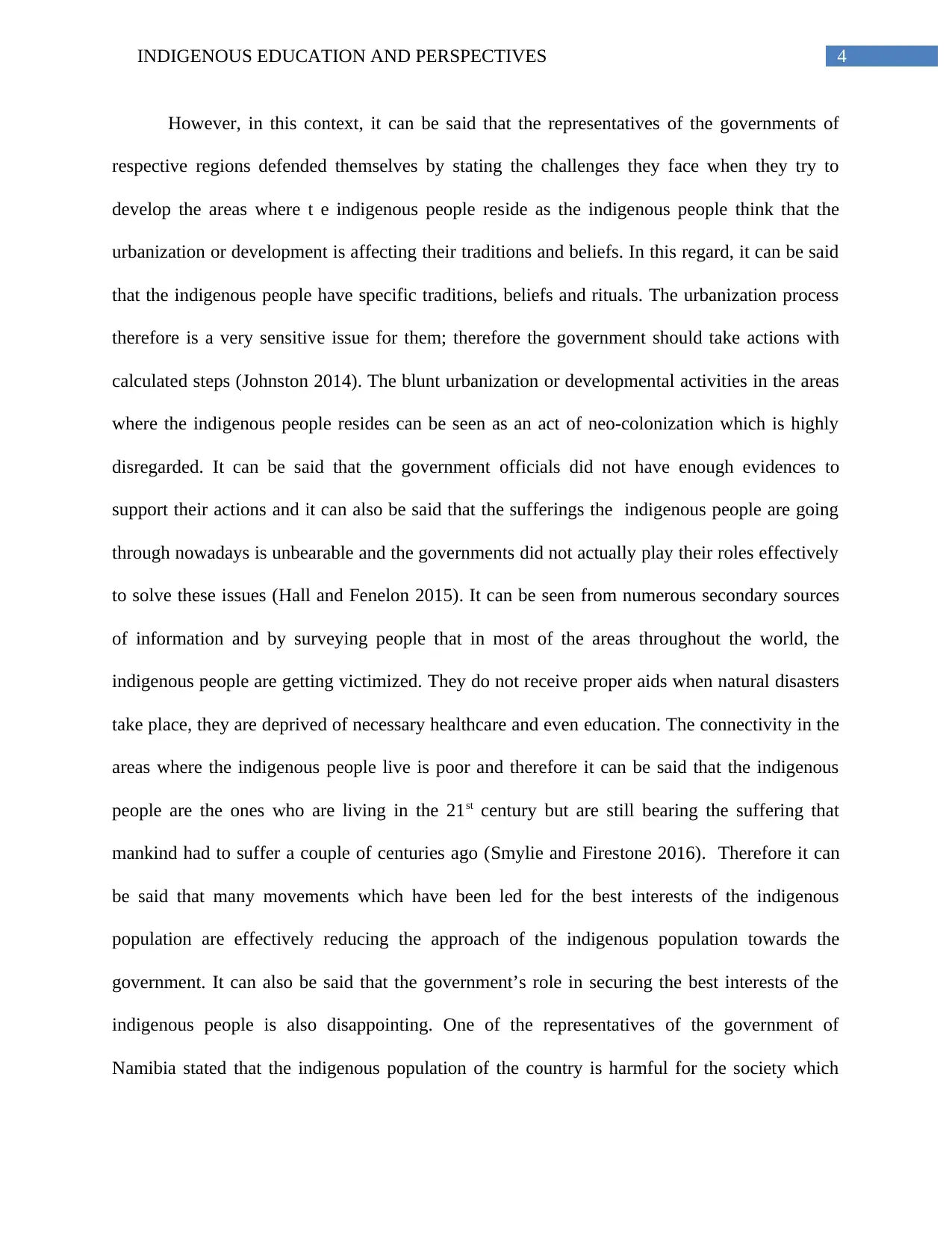
4INDIGENOUS EDUCATION AND PERSPECTIVES
However, in this context, it can be said that the representatives of the governments of
respective regions defended themselves by stating the challenges they face when they try to
develop the areas where t e indigenous people reside as the indigenous people think that the
urbanization or development is affecting their traditions and beliefs. In this regard, it can be said
that the indigenous people have specific traditions, beliefs and rituals. The urbanization process
therefore is a very sensitive issue for them; therefore the government should take actions with
calculated steps (Johnston 2014). The blunt urbanization or developmental activities in the areas
where the indigenous people resides can be seen as an act of neo-colonization which is highly
disregarded. It can be said that the government officials did not have enough evidences to
support their actions and it can also be said that the sufferings the indigenous people are going
through nowadays is unbearable and the governments did not actually play their roles effectively
to solve these issues (Hall and Fenelon 2015). It can be seen from numerous secondary sources
of information and by surveying people that in most of the areas throughout the world, the
indigenous people are getting victimized. They do not receive proper aids when natural disasters
take place, they are deprived of necessary healthcare and even education. The connectivity in the
areas where the indigenous people live is poor and therefore it can be said that the indigenous
people are the ones who are living in the 21st century but are still bearing the suffering that
mankind had to suffer a couple of centuries ago (Smylie and Firestone 2016). Therefore it can
be said that many movements which have been led for the best interests of the indigenous
population are effectively reducing the approach of the indigenous population towards the
government. It can also be said that the government’s role in securing the best interests of the
indigenous people is also disappointing. One of the representatives of the government of
Namibia stated that the indigenous population of the country is harmful for the society which
However, in this context, it can be said that the representatives of the governments of
respective regions defended themselves by stating the challenges they face when they try to
develop the areas where t e indigenous people reside as the indigenous people think that the
urbanization or development is affecting their traditions and beliefs. In this regard, it can be said
that the indigenous people have specific traditions, beliefs and rituals. The urbanization process
therefore is a very sensitive issue for them; therefore the government should take actions with
calculated steps (Johnston 2014). The blunt urbanization or developmental activities in the areas
where the indigenous people resides can be seen as an act of neo-colonization which is highly
disregarded. It can be said that the government officials did not have enough evidences to
support their actions and it can also be said that the sufferings the indigenous people are going
through nowadays is unbearable and the governments did not actually play their roles effectively
to solve these issues (Hall and Fenelon 2015). It can be seen from numerous secondary sources
of information and by surveying people that in most of the areas throughout the world, the
indigenous people are getting victimized. They do not receive proper aids when natural disasters
take place, they are deprived of necessary healthcare and even education. The connectivity in the
areas where the indigenous people live is poor and therefore it can be said that the indigenous
people are the ones who are living in the 21st century but are still bearing the suffering that
mankind had to suffer a couple of centuries ago (Smylie and Firestone 2016). Therefore it can
be said that many movements which have been led for the best interests of the indigenous
population are effectively reducing the approach of the indigenous population towards the
government. It can also be said that the government’s role in securing the best interests of the
indigenous people is also disappointing. One of the representatives of the government of
Namibia stated that the indigenous population of the country is harmful for the society which
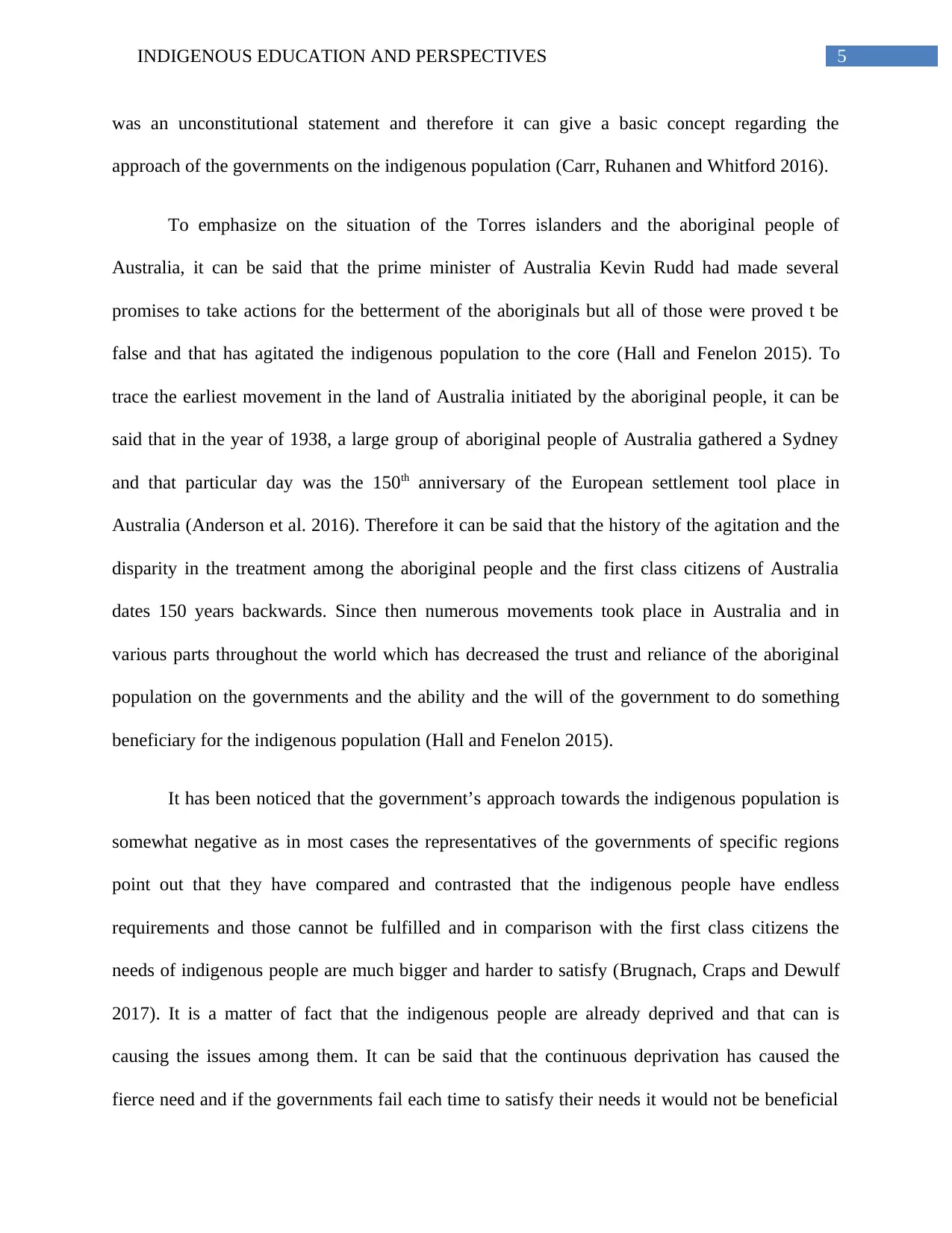
5INDIGENOUS EDUCATION AND PERSPECTIVES
was an unconstitutional statement and therefore it can give a basic concept regarding the
approach of the governments on the indigenous population (Carr, Ruhanen and Whitford 2016).
To emphasize on the situation of the Torres islanders and the aboriginal people of
Australia, it can be said that the prime minister of Australia Kevin Rudd had made several
promises to take actions for the betterment of the aboriginals but all of those were proved t be
false and that has agitated the indigenous population to the core (Hall and Fenelon 2015). To
trace the earliest movement in the land of Australia initiated by the aboriginal people, it can be
said that in the year of 1938, a large group of aboriginal people of Australia gathered a Sydney
and that particular day was the 150th anniversary of the European settlement tool place in
Australia (Anderson et al. 2016). Therefore it can be said that the history of the agitation and the
disparity in the treatment among the aboriginal people and the first class citizens of Australia
dates 150 years backwards. Since then numerous movements took place in Australia and in
various parts throughout the world which has decreased the trust and reliance of the aboriginal
population on the governments and the ability and the will of the government to do something
beneficiary for the indigenous population (Hall and Fenelon 2015).
It has been noticed that the government’s approach towards the indigenous population is
somewhat negative as in most cases the representatives of the governments of specific regions
point out that they have compared and contrasted that the indigenous people have endless
requirements and those cannot be fulfilled and in comparison with the first class citizens the
needs of indigenous people are much bigger and harder to satisfy (Brugnach, Craps and Dewulf
2017). It is a matter of fact that the indigenous people are already deprived and that can is
causing the issues among them. It can be said that the continuous deprivation has caused the
fierce need and if the governments fail each time to satisfy their needs it would not be beneficial
was an unconstitutional statement and therefore it can give a basic concept regarding the
approach of the governments on the indigenous population (Carr, Ruhanen and Whitford 2016).
To emphasize on the situation of the Torres islanders and the aboriginal people of
Australia, it can be said that the prime minister of Australia Kevin Rudd had made several
promises to take actions for the betterment of the aboriginals but all of those were proved t be
false and that has agitated the indigenous population to the core (Hall and Fenelon 2015). To
trace the earliest movement in the land of Australia initiated by the aboriginal people, it can be
said that in the year of 1938, a large group of aboriginal people of Australia gathered a Sydney
and that particular day was the 150th anniversary of the European settlement tool place in
Australia (Anderson et al. 2016). Therefore it can be said that the history of the agitation and the
disparity in the treatment among the aboriginal people and the first class citizens of Australia
dates 150 years backwards. Since then numerous movements took place in Australia and in
various parts throughout the world which has decreased the trust and reliance of the aboriginal
population on the governments and the ability and the will of the government to do something
beneficiary for the indigenous population (Hall and Fenelon 2015).
It has been noticed that the government’s approach towards the indigenous population is
somewhat negative as in most cases the representatives of the governments of specific regions
point out that they have compared and contrasted that the indigenous people have endless
requirements and those cannot be fulfilled and in comparison with the first class citizens the
needs of indigenous people are much bigger and harder to satisfy (Brugnach, Craps and Dewulf
2017). It is a matter of fact that the indigenous people are already deprived and that can is
causing the issues among them. It can be said that the continuous deprivation has caused the
fierce need and if the governments fail each time to satisfy their needs it would not be beneficial
⊘ This is a preview!⊘
Do you want full access?
Subscribe today to unlock all pages.

Trusted by 1+ million students worldwide
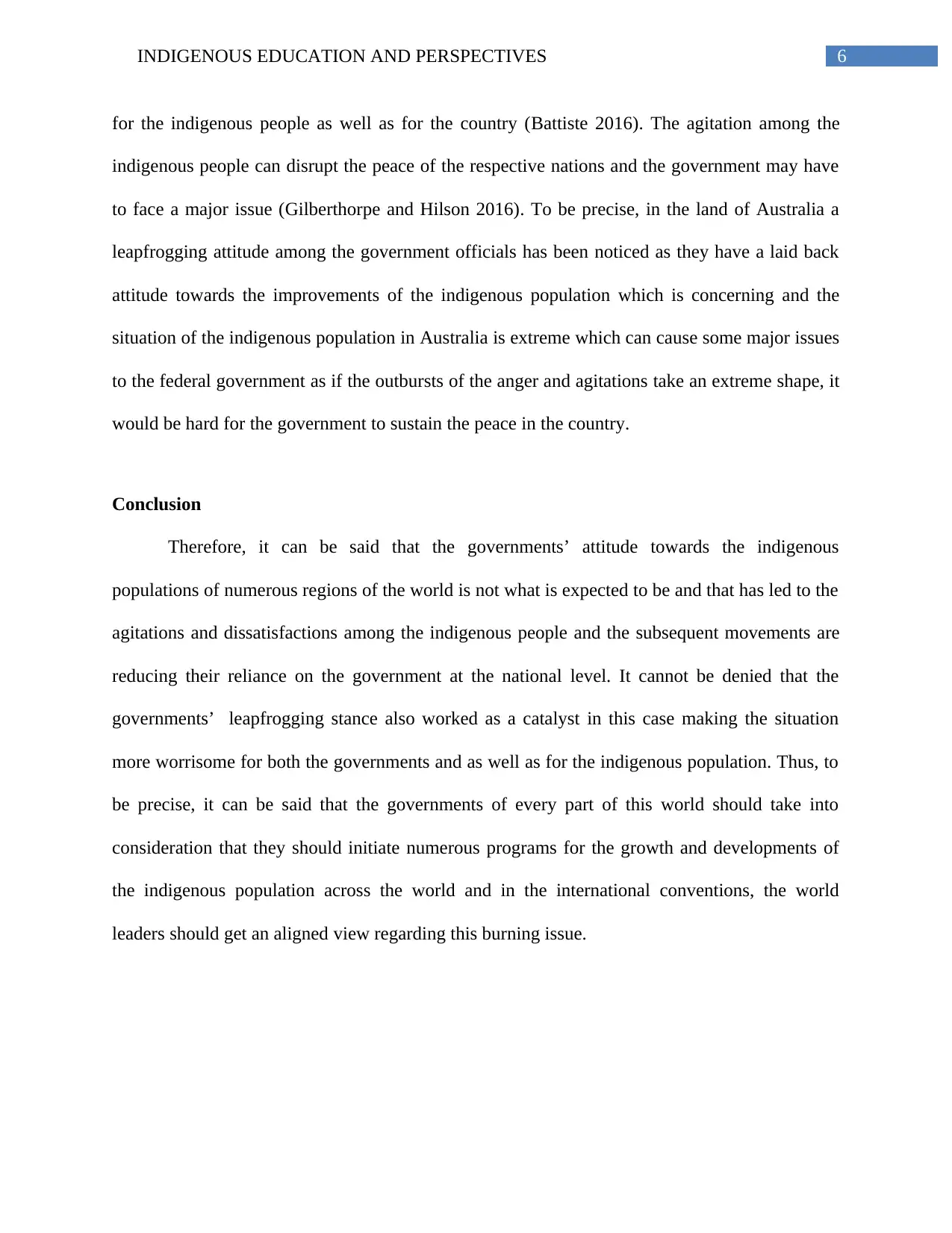
6INDIGENOUS EDUCATION AND PERSPECTIVES
for the indigenous people as well as for the country (Battiste 2016). The agitation among the
indigenous people can disrupt the peace of the respective nations and the government may have
to face a major issue (Gilberthorpe and Hilson 2016). To be precise, in the land of Australia a
leapfrogging attitude among the government officials has been noticed as they have a laid back
attitude towards the improvements of the indigenous population which is concerning and the
situation of the indigenous population in Australia is extreme which can cause some major issues
to the federal government as if the outbursts of the anger and agitations take an extreme shape, it
would be hard for the government to sustain the peace in the country.
Conclusion
Therefore, it can be said that the governments’ attitude towards the indigenous
populations of numerous regions of the world is not what is expected to be and that has led to the
agitations and dissatisfactions among the indigenous people and the subsequent movements are
reducing their reliance on the government at the national level. It cannot be denied that the
governments’ leapfrogging stance also worked as a catalyst in this case making the situation
more worrisome for both the governments and as well as for the indigenous population. Thus, to
be precise, it can be said that the governments of every part of this world should take into
consideration that they should initiate numerous programs for the growth and developments of
the indigenous population across the world and in the international conventions, the world
leaders should get an aligned view regarding this burning issue.
for the indigenous people as well as for the country (Battiste 2016). The agitation among the
indigenous people can disrupt the peace of the respective nations and the government may have
to face a major issue (Gilberthorpe and Hilson 2016). To be precise, in the land of Australia a
leapfrogging attitude among the government officials has been noticed as they have a laid back
attitude towards the improvements of the indigenous population which is concerning and the
situation of the indigenous population in Australia is extreme which can cause some major issues
to the federal government as if the outbursts of the anger and agitations take an extreme shape, it
would be hard for the government to sustain the peace in the country.
Conclusion
Therefore, it can be said that the governments’ attitude towards the indigenous
populations of numerous regions of the world is not what is expected to be and that has led to the
agitations and dissatisfactions among the indigenous people and the subsequent movements are
reducing their reliance on the government at the national level. It cannot be denied that the
governments’ leapfrogging stance also worked as a catalyst in this case making the situation
more worrisome for both the governments and as well as for the indigenous population. Thus, to
be precise, it can be said that the governments of every part of this world should take into
consideration that they should initiate numerous programs for the growth and developments of
the indigenous population across the world and in the international conventions, the world
leaders should get an aligned view regarding this burning issue.
Paraphrase This Document
Need a fresh take? Get an instant paraphrase of this document with our AI Paraphraser
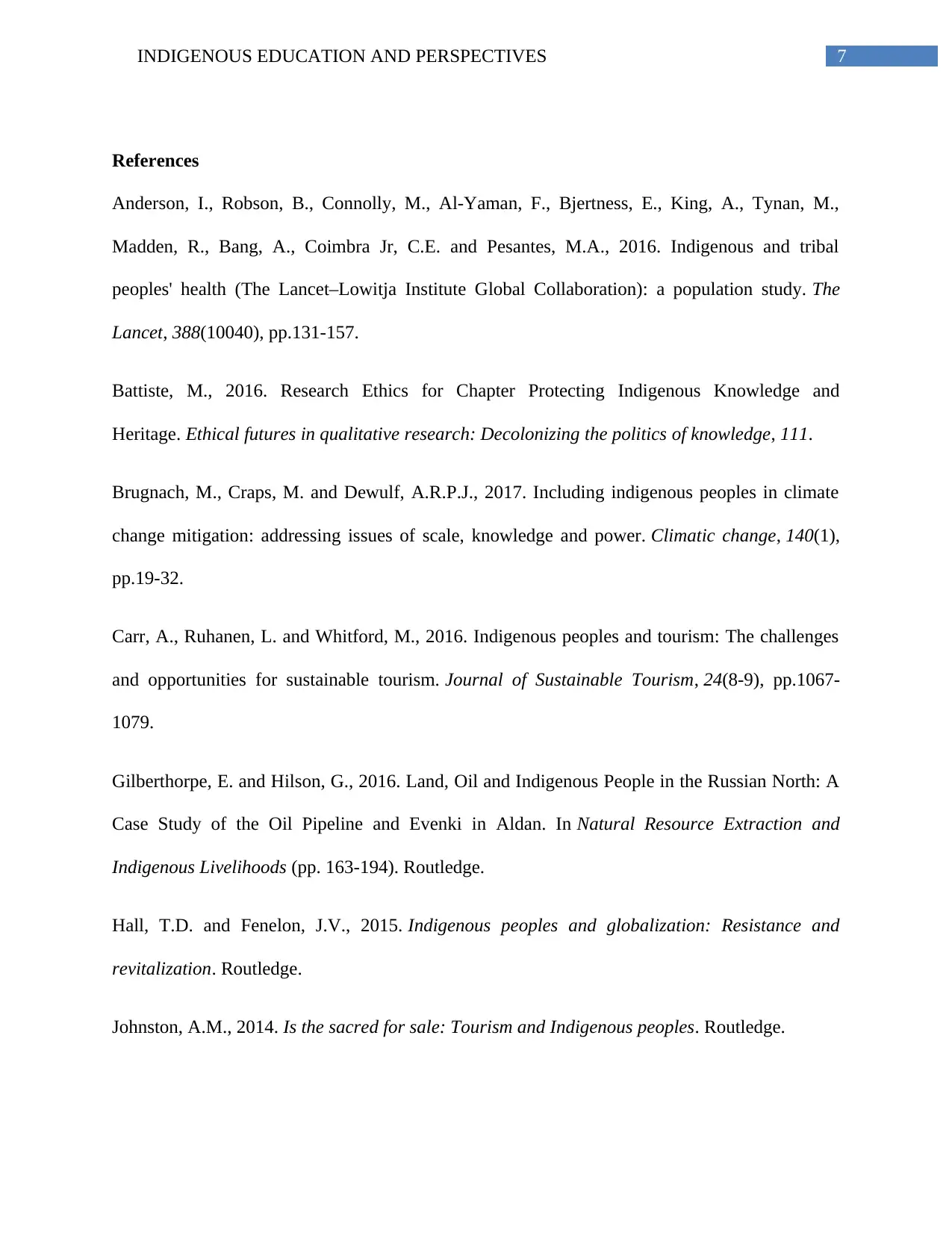
7INDIGENOUS EDUCATION AND PERSPECTIVES
References
Anderson, I., Robson, B., Connolly, M., Al-Yaman, F., Bjertness, E., King, A., Tynan, M.,
Madden, R., Bang, A., Coimbra Jr, C.E. and Pesantes, M.A., 2016. Indigenous and tribal
peoples' health (The Lancet–Lowitja Institute Global Collaboration): a population study. The
Lancet, 388(10040), pp.131-157.
Battiste, M., 2016. Research Ethics for Chapter Protecting Indigenous Knowledge and
Heritage. Ethical futures in qualitative research: Decolonizing the politics of knowledge, 111.
Brugnach, M., Craps, M. and Dewulf, A.R.P.J., 2017. Including indigenous peoples in climate
change mitigation: addressing issues of scale, knowledge and power. Climatic change, 140(1),
pp.19-32.
Carr, A., Ruhanen, L. and Whitford, M., 2016. Indigenous peoples and tourism: The challenges
and opportunities for sustainable tourism. Journal of Sustainable Tourism, 24(8-9), pp.1067-
1079.
Gilberthorpe, E. and Hilson, G., 2016. Land, Oil and Indigenous People in the Russian North: A
Case Study of the Oil Pipeline and Evenki in Aldan. In Natural Resource Extraction and
Indigenous Livelihoods (pp. 163-194). Routledge.
Hall, T.D. and Fenelon, J.V., 2015. Indigenous peoples and globalization: Resistance and
revitalization. Routledge.
Johnston, A.M., 2014. Is the sacred for sale: Tourism and Indigenous peoples. Routledge.
References
Anderson, I., Robson, B., Connolly, M., Al-Yaman, F., Bjertness, E., King, A., Tynan, M.,
Madden, R., Bang, A., Coimbra Jr, C.E. and Pesantes, M.A., 2016. Indigenous and tribal
peoples' health (The Lancet–Lowitja Institute Global Collaboration): a population study. The
Lancet, 388(10040), pp.131-157.
Battiste, M., 2016. Research Ethics for Chapter Protecting Indigenous Knowledge and
Heritage. Ethical futures in qualitative research: Decolonizing the politics of knowledge, 111.
Brugnach, M., Craps, M. and Dewulf, A.R.P.J., 2017. Including indigenous peoples in climate
change mitigation: addressing issues of scale, knowledge and power. Climatic change, 140(1),
pp.19-32.
Carr, A., Ruhanen, L. and Whitford, M., 2016. Indigenous peoples and tourism: The challenges
and opportunities for sustainable tourism. Journal of Sustainable Tourism, 24(8-9), pp.1067-
1079.
Gilberthorpe, E. and Hilson, G., 2016. Land, Oil and Indigenous People in the Russian North: A
Case Study of the Oil Pipeline and Evenki in Aldan. In Natural Resource Extraction and
Indigenous Livelihoods (pp. 163-194). Routledge.
Hall, T.D. and Fenelon, J.V., 2015. Indigenous peoples and globalization: Resistance and
revitalization. Routledge.
Johnston, A.M., 2014. Is the sacred for sale: Tourism and Indigenous peoples. Routledge.
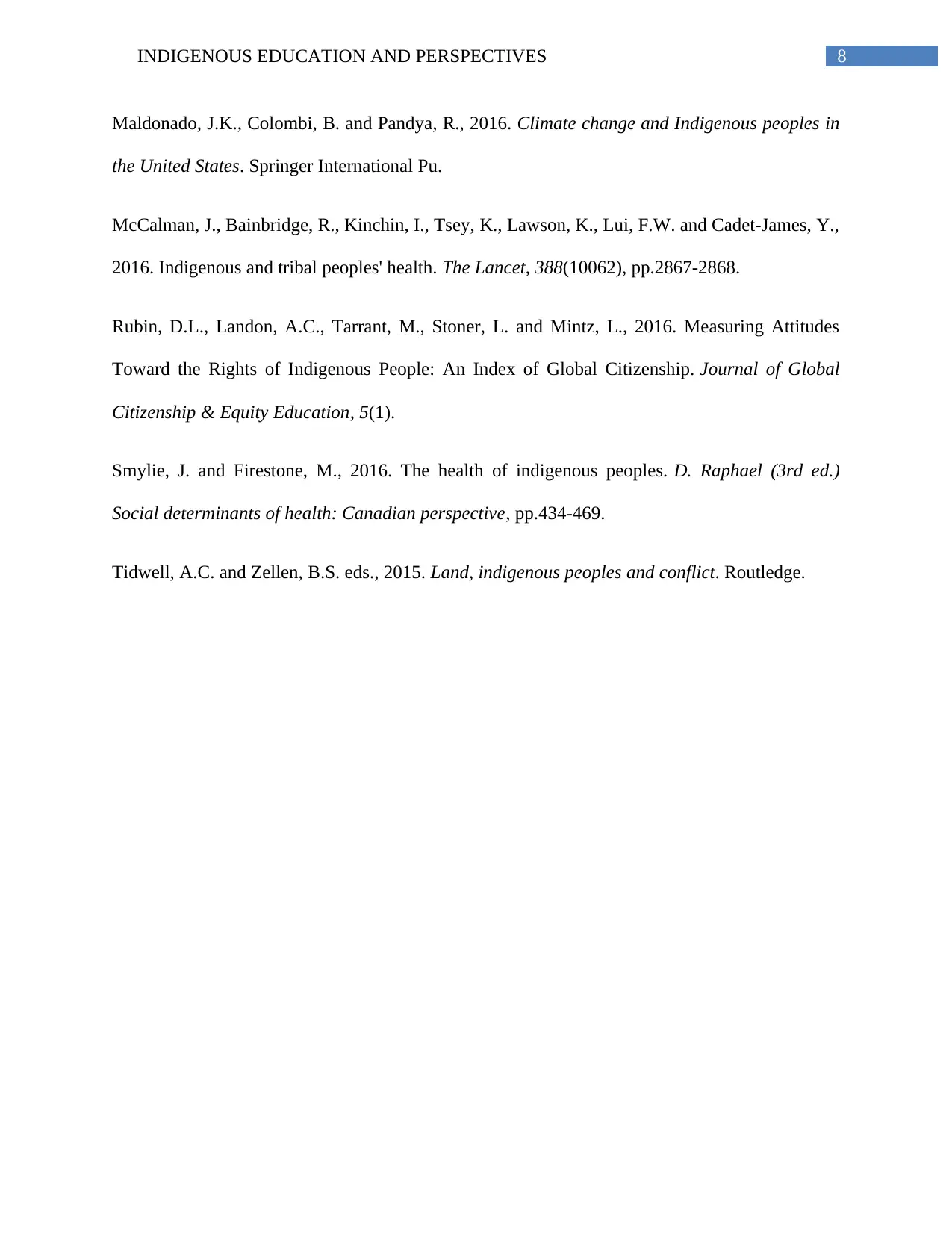
8INDIGENOUS EDUCATION AND PERSPECTIVES
Maldonado, J.K., Colombi, B. and Pandya, R., 2016. Climate change and Indigenous peoples in
the United States. Springer International Pu.
McCalman, J., Bainbridge, R., Kinchin, I., Tsey, K., Lawson, K., Lui, F.W. and Cadet-James, Y.,
2016. Indigenous and tribal peoples' health. The Lancet, 388(10062), pp.2867-2868.
Rubin, D.L., Landon, A.C., Tarrant, M., Stoner, L. and Mintz, L., 2016. Measuring Attitudes
Toward the Rights of Indigenous People: An Index of Global Citizenship. Journal of Global
Citizenship & Equity Education, 5(1).
Smylie, J. and Firestone, M., 2016. The health of indigenous peoples. D. Raphael (3rd ed.)
Social determinants of health: Canadian perspective, pp.434-469.
Tidwell, A.C. and Zellen, B.S. eds., 2015. Land, indigenous peoples and conflict. Routledge.
Maldonado, J.K., Colombi, B. and Pandya, R., 2016. Climate change and Indigenous peoples in
the United States. Springer International Pu.
McCalman, J., Bainbridge, R., Kinchin, I., Tsey, K., Lawson, K., Lui, F.W. and Cadet-James, Y.,
2016. Indigenous and tribal peoples' health. The Lancet, 388(10062), pp.2867-2868.
Rubin, D.L., Landon, A.C., Tarrant, M., Stoner, L. and Mintz, L., 2016. Measuring Attitudes
Toward the Rights of Indigenous People: An Index of Global Citizenship. Journal of Global
Citizenship & Equity Education, 5(1).
Smylie, J. and Firestone, M., 2016. The health of indigenous peoples. D. Raphael (3rd ed.)
Social determinants of health: Canadian perspective, pp.434-469.
Tidwell, A.C. and Zellen, B.S. eds., 2015. Land, indigenous peoples and conflict. Routledge.
⊘ This is a preview!⊘
Do you want full access?
Subscribe today to unlock all pages.

Trusted by 1+ million students worldwide
1 out of 9
Related Documents
Your All-in-One AI-Powered Toolkit for Academic Success.
+13062052269
info@desklib.com
Available 24*7 on WhatsApp / Email
![[object Object]](/_next/static/media/star-bottom.7253800d.svg)
Unlock your academic potential
Copyright © 2020–2025 A2Z Services. All Rights Reserved. Developed and managed by ZUCOL.




